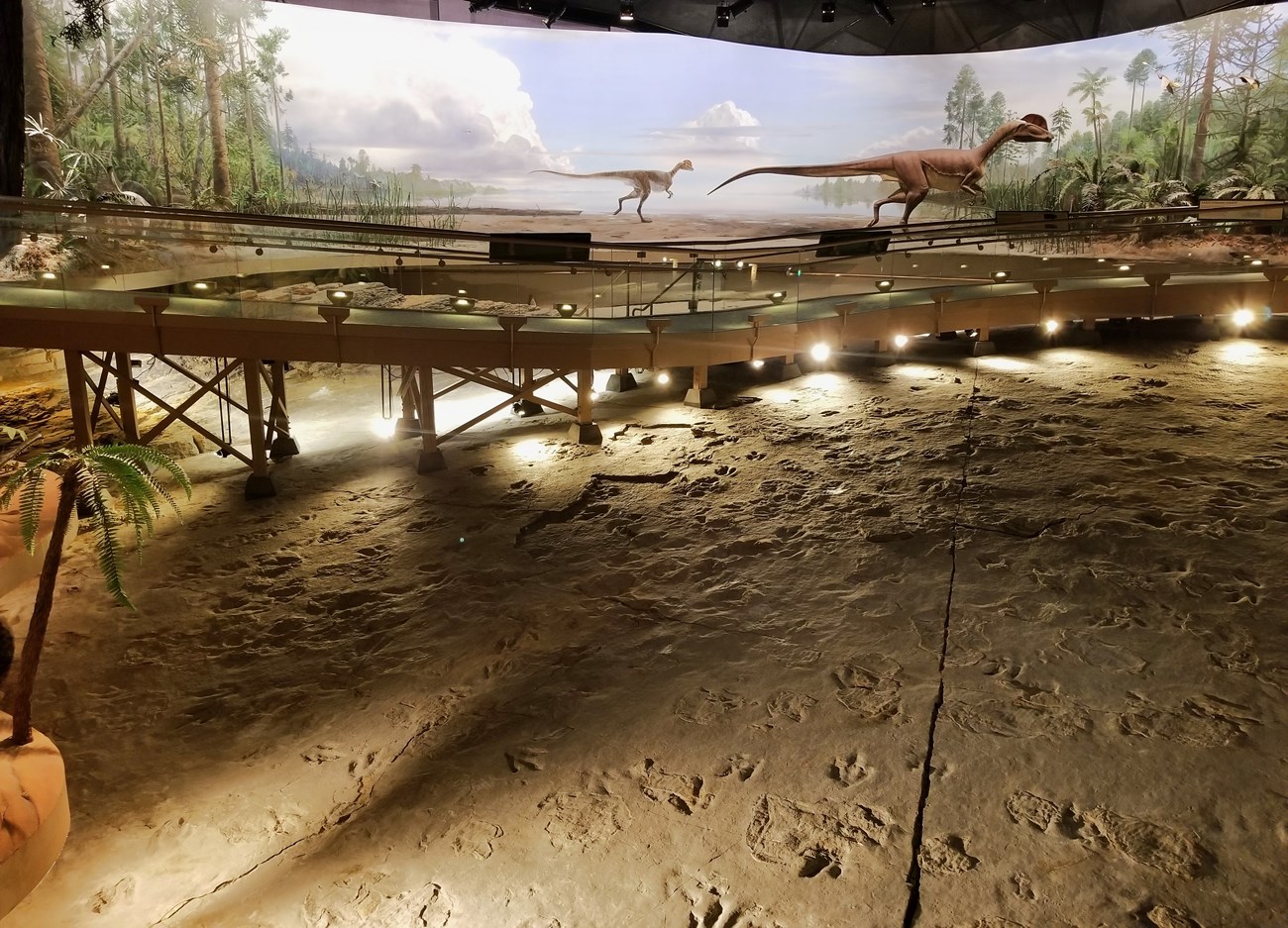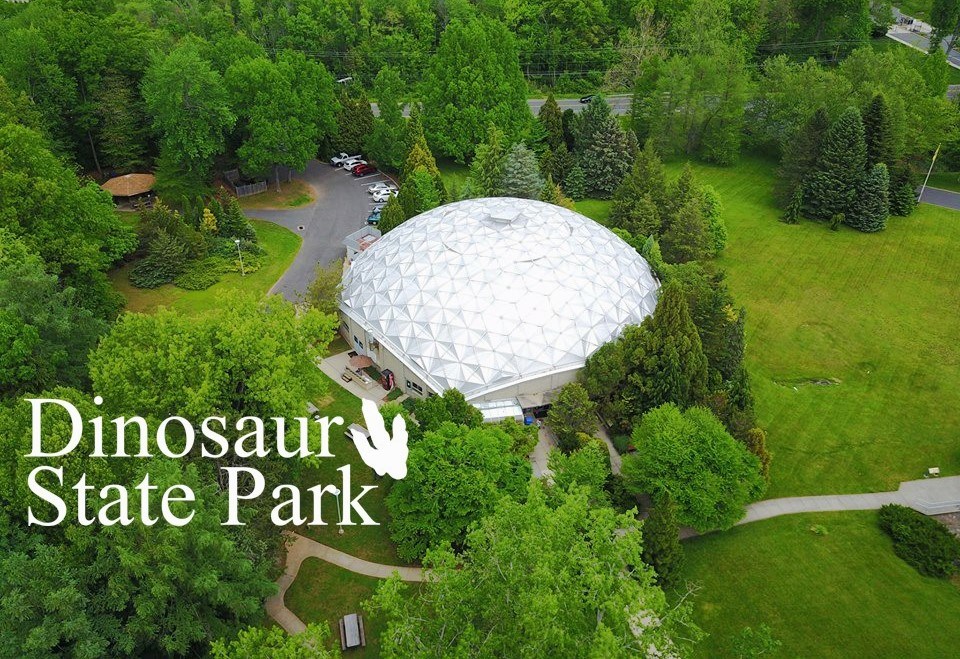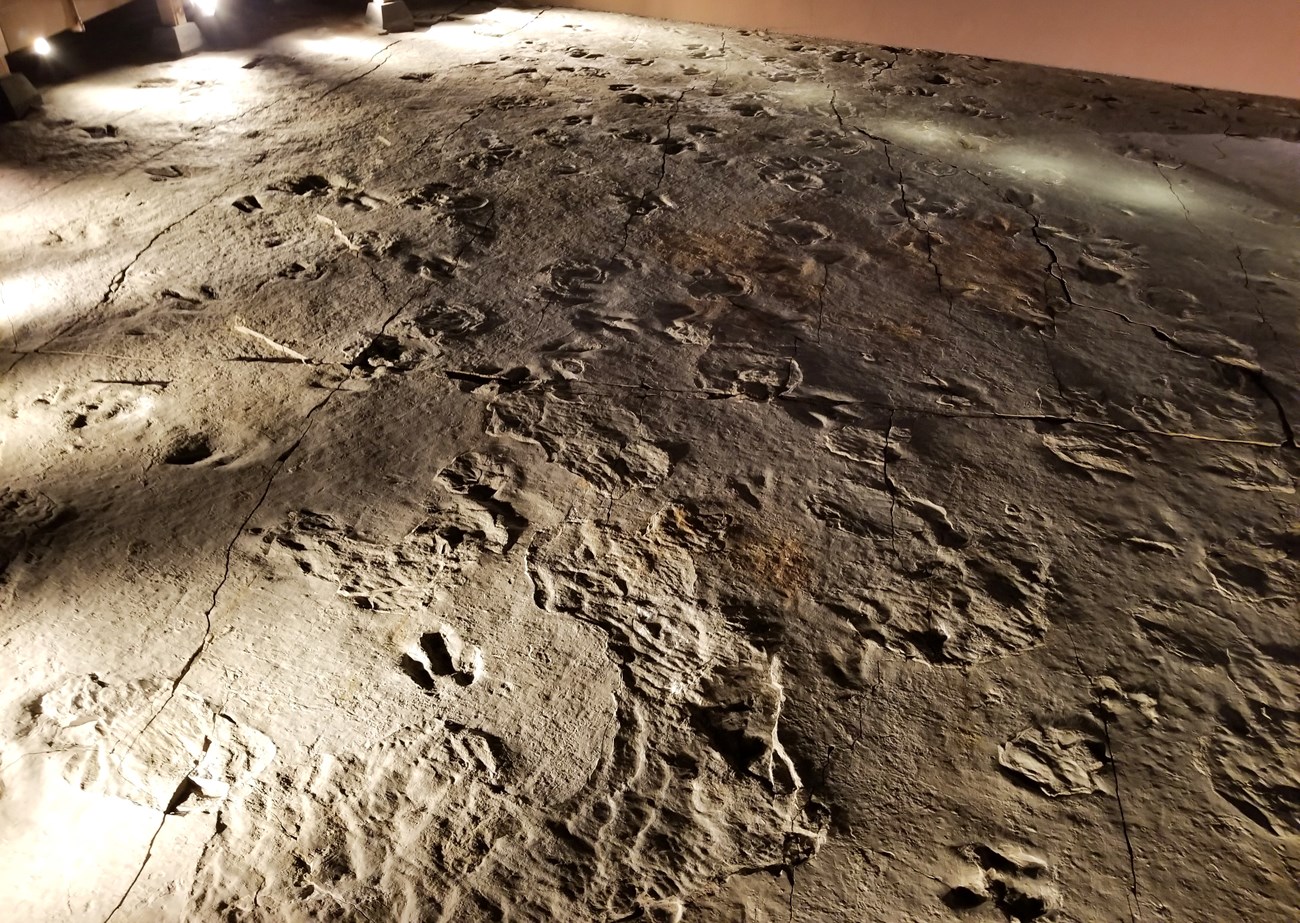Part of a series of articles titled Park Paleontology News - Vol. 16, No. 1, Spring 2024.
Article
Paleontology of Dinosaur Trackway National Natural Landmark

Article by Justin Tweet, paleontologist
NPS Paleontology Program
for Park Paleontology Newsletter, Spring 2024

Photo courtesy of Michael Ross, Environmental Education Coordinator/Park Supervisor, Dinosaur State Park, Connecticut Department of Energy & Environmental Protection.
American dinosaur fossils are famously known from remote areas of western states, but they are not limited to these areas. Some of the first dinosaur fossils reported from the United States are footprints found in New England. In fact, they were discovered before the concept of "dinosaurs" existed and were therefore interpreted as the footprints of birds. In hindsight, this was not far off the mark, because the small to medium-sized carnivorous dinosaurs that left the tracks were early relatives of birds. Outstanding examples of these New England dinosaur tracks can be seen at Dinosaur Trackway National Natural Landmark (NNL), within Dinosaur State Park and Arboretum in Rocky Hill, central Connecticut.
Mesozoic rocks are relatively rare in much of the eastern and central U.S., except for areas that were near Cretaceous coasts. New England is one of the exceptions to this rule: The Connecticut River Valley is one of several areas in eastern North America where long, narrow, deep rift valleys formed from the Late Triassic into the Early Jurassic (between 230 and 190 million years ago), during the breakup of the supercontinent Pangaea. New England was farther south at that time, in tropical latitudes, and would have been much warmer than today. As North America separated from Africa and other landmasses, rift valleys formed paralleling the future Atlantic Ocean. At different times these basins were filled with lava flows, lakes, or rivers and floodplains. Fossils preserve evidence of ancient life when the basins were hospitable. Very few body fossils from land-dwelling vertebrates like dinosaurs have been found, but thousands of footprints have been discovered. Dinosaurs were represented by bipedal carnivores (theropods) similar to Coelophysis and the larger crested Dilophosaurus, early sauropod relatives such as Anchisaurus, and small beaked bipedal herbivores. Because most of the dinosaurs are only known from tracks, we know them through special names assigned to footprints. For example, the abundant small theropod tracks are called Grallator, and the common large theropod tracks are Eubrontes. The theropods that made these tracks were probably fishers around the edges of lakes and streams.

Photo courtesy of Michael Ross.
The scientific history of the fossil footprints of the Connecticut River Valley goes back to the beginning of the 19th century, but people are still making discoveries. The fossils of Dinosaur Trackway NNL were completely unknown until August 23, 1966, when bulldozer operator Edward McCarthy uncovered footprints while excavating for a planned Connecticut State Highway Department laboratory at Rocky Hill. Scientists at regional institutions such as the Peabody Museum of Natural History (Yale), the University of Connecticut, and the State Geological and Natural History Survey were quickly alerted, and the site was soon under protection and investigation. On September 13, 1966, just a few weeks after the discovery, Dinosaur State Park was founded, and in April 1968 the fossil locality became a National Natural Landmark. Today, Dinosaur State Park and Arboretum is administered by the Connecticut Department of Energy and Environmental Protection and welcomes tens of thousands of visitors a year.
The initial discovery proved to be part of a larger area with approximately 1500 footprints. More tracks were discovered nearby, including approximately 700 in a smaller area west of the initial discovery. The first, larger area was left uncovered until 1976, but has been buried since then to protect it from weathering; a structure to cover these tracks has always been planned but funding has not been available to construct one. The smaller area has been protected by a distinctive geodesic dome since 1978, after having been under a temporary inflatable building for several years.

Photo courtesy of Michael Ross.
The fossil track-bearing strata are part of a rock unit called the East Berlin Formation. The fossiliferous beds are gray sandstones, siltstones, and mudstones deposited toward the end of a lake cycle in the ancient rift valley, so some features show exposure to air (such as mud cracks and raindrop impressions) and others show deposition by water (such as ripple marks and cross-bedding). We can picture the dinosaurs and other animals walking around a shallow lake. By correlation with strata exposed elsewhere, it is known that basalt beds representing lava flows are present approximately 140 ft (42 m) above the track layers, and show that the track layers are about 200 million years old, just after the beginning of the Jurassic. Today the beds dip to the south because of the rifting that was occurring during and after they were deposited.

Photo courtesy of Michael Ross
Several types of fossil footprints have been identified at Dinosaur Trackway NNL. The most abundant are three-toed footprints classified as Eubrontes, left by a large theropod probably similar to Dilophosaurus. The tracks are on the order of 9 to 18 inches long (30 to 45 centimeters), with a stride of about 3.5 to 4.5 feet (1.1 to 1.4 meters). Eubrontes was declared Connecticut’s state fossil in 1991, in part due to its prominence at Dinosaur State Park. Next are footprints identified as Anchisauripus, from medium-sized theropods (not herbivores like Anchisaurus, despite the name). Finally, there are rare footprints identified as Batrachopus, probably made by a small crocodile relative, and Grallator, made by a small theropod.
Unlike some fossil track sites, the trackways at Dinosaur Trackway NNL appear to show no preferred direction of travel. Evidence suggests that these dinosaurs were fishing near the shore in shallow lakes. Some tracks were first thought to represent swimming traces, but more study and observation of modern bird tracks suggest the "swim" tracks may just represent animals walking on areas of firm substrates (such as drying mud). The footprints are mostly found on two layers separated by about 1 vertical inch (2 to 3 centimeters), with most of the tracks on the lower layer being underprints (marks formed at depth below a footprint due to the pressure of the foot). The main track level represents a short period of time, perhaps only a day or so, maybe a month or more if some tracks are truly swimming (which would require rapid water rise in the basin).

Photo courtesy of Michael Ross.
Visitors to the state park can observe areas of two track surfaces in the exhibit center, where more than 750 tracks are visible. Here the track surfaces are partially surrounded by artwork picturing the life and landscape just before and during the time the tracks were created by roaming reptiles. Study continues on the tracks, including new methods such as photogrammetry (using multiple photos to create a three-dimensional model). This not only allows the tracks to be studied in a digital environment, but also makes it possible to print 3D copies of tracks for study and education. In addition to the track surfaces, the exhibit center also includes fossils found elsewhere in the Connecticut River Valley, and surrounding the exhibit center is an arboretum focused on plants that are comparable to or related to the plants that would have grown here during the Mesozoic.

Photo courtesy of Michael Ross.
Administered by the National Park Service, the National Natural Landmark Program recognizes and supports the voluntary conservation of exemplary biological and geological sites that illustrate the nation’s natural heritage, including those that contain significant paleontological resources. National natural landmarks are designated by the Secretary of the Interior and are owned by a variety of public and private stewards. To date, significant paleontological resources have contributed, in whole or in part, to the designation of 58 National Natural Landmark sites across the country, and paleontological resources are known at many others as well. These landmarks represent the range of geologic history from very early marine life 510 million years ago to more recent (40,000 years ago) fossil mammals.

Photo provided by Deborah DiQuinzio, National Park Service.
Related Links
Last updated: April 3, 2024
